#Grubhub Script
Explore tagged Tumblr posts
Text
Sometimes the existence of ChatGPT is really funny because I’m trying to cancel a grubhub order and now they’re making me text a customer service person who may or may not be a robot. I can’t tell if they’re a computer or just following a very specific script.
#hylian rambles#grubhub is going on the list of companies that annoy me now#stop making me talk to people just to cancel things#i think they're stalling so i run out of cancel time#oh nevermind they canceled it now#still convinced that may have been a robot
3 notes
·
View notes
Text
Monitor Competitor Pricing with Food Delivery Data Scraping

In the highly competitive food delivery industry, pricing can be the deciding factor between winning and losing a customer. With the rise of aggregators like DoorDash, Uber Eats, Zomato, Swiggy, and Grubhub, users can compare restaurant options, menus, and—most importantly—prices in just a few taps. To stay ahead, food delivery businesses must continually monitor how competitors are pricing similar items. And that’s where food delivery data scraping comes in.
Data scraping enables restaurants, cloud kitchens, and food delivery platforms to gather real-time competitor data, analyze market trends, and adjust strategies proactively. In this blog, we’ll explore how to use web scraping to monitor competitor pricing effectively, the benefits it offers, and how to do it legally and efficiently.
What Is Food Delivery Data Scraping?
Data scraping is the automated process of extracting information from websites. In the food delivery sector, this means using tools or scripts to collect data from food delivery platforms, restaurant listings, and menu pages.
What Can Be Scraped?
Menu items and categories
Product pricing
Delivery fees and taxes
Discounts and special offers
Restaurant ratings and reviews
Delivery times and availability
This data is invaluable for competitive benchmarking and dynamic pricing strategies.
Why Monitoring Competitor Pricing Matters
1. Stay Competitive in Real Time
Consumers often choose based on pricing. If your competitor offers a similar dish for less, you may lose the order. Monitoring competitor prices lets you react quickly to price changes and stay attractive to customers.
2. Optimize Your Menu Strategy
Scraped data helps identify:
Popular food items in your category
Price points that perform best
How competitors bundle or upsell meals
This allows for smarter decisions around menu engineering and profit margin optimization.
3. Understand Regional Pricing Trends
If you operate across multiple locations or cities, scraping competitor data gives insights into:
Area-specific pricing
Demand-based variation
Local promotions and discounts
This enables geo-targeted pricing strategies.
4. Identify Gaps in the Market
Maybe no competitor offers free delivery during weekdays or a combo meal under $10. Real-time data helps spot such gaps and create offers that attract value-driven users.
How Food Delivery Data Scraping Works
Step 1: Choose Your Target Platforms
Most scraping projects start with identifying where your competitors are listed. Common targets include:
Aggregators: Uber Eats, Zomato, DoorDash, Grubhub
Direct restaurant websites
POS platforms (where available)
Step 2: Define What You Want to Track
Set scraping goals. For pricing, track:
Base prices of dishes
Add-ons and customization costs
Time-sensitive deals
Delivery fees by location or vendor
Step 3: Use Web Scraping Tools or Custom Scripts
You can either:
Use scraping tools like Octoparse, ParseHub, Apify, or
Build custom scripts in Python using libraries like BeautifulSoup, Selenium, or Scrapy
These tools automate the extraction of relevant data and organize it in a structured format (CSV, Excel, or database).
Step 4: Automate Scheduling and Alerts
Set scraping intervals (daily, hourly, weekly) and create alerts for major pricing changes. This ensures your team is always equipped with the latest data.
Step 5: Analyze the Data
Feed the scraped data into BI tools like Power BI, Google Data Studio, or Tableau to identify patterns and inform strategic decisions.
Tools and Technologies for Effective Scraping
Popular Tools:
Scrapy: Python-based framework perfect for complex projects
BeautifulSoup: Great for parsing HTML and small-scale tasks
Selenium: Ideal for scraping dynamic pages with JavaScript
Octoparse: No-code solution with scheduling and cloud support
Apify: Advanced, scalable platform with ready-to-use APIs
Hosting and Automation:
Use cron jobs or task schedulers for automation
Store data on cloud databases like AWS RDS, MongoDB Atlas, or Google BigQuery
Legal Considerations: Is It Ethical to Scrape Food Delivery Platforms?
This is a critical aspect of scraping.
Understand Platform Terms
Many websites explicitly state in their Terms of Service that scraping is not allowed. Scraping such platforms can violate those terms, even if it’s not technically illegal.
Avoid Harming Website Performance
Always scrape responsibly:
Use rate limiting to avoid overloading servers
Respect robots.txt files
Avoid scraping login-protected or personal user data
Use Publicly Available Data
Stick to scraping data that’s:
Publicly accessible
Not behind paywalls or logins
Not personally identifiable or sensitive
If possible, work with third-party data providers who have pre-approved partnerships or APIs.
Real-World Use Cases of Price Monitoring via Scraping
A. Cloud Kitchens
A cloud kitchen operating in three cities uses scraping to monitor average pricing for biryani and wraps. Based on competitor pricing, they adjust their bundle offers and introduce combo meals—boosting order value by 22%.
B. Local Restaurants
A family-owned restaurant tracks rival pricing and delivery fees during weekends. By offering a free dessert on orders above $25 (when competitors don’t), they see a 15% increase in weekend orders.
C. Food Delivery Startups
A new delivery aggregator monitors established players’ pricing to craft a price-beating strategy, helping them enter the market with aggressive discounts and gain traction.
Key Metrics to Track Through Price Scraping
When setting up your monitoring dashboard, focus on:
Average price per cuisine category
Price differences across cities or neighborhoods
Top 10 lowest/highest priced items in your segment
Frequency of discounts and offers
Delivery fee trends by time and distance
Most used upsell combinations (e.g., sides, drinks)
Challenges in Food Delivery Data Scraping (And Solutions)
Challenge 1: Dynamic Content and JavaScript-Heavy Pages
Solution: Use headless browsers like Selenium or platforms like Puppeteer to scrape rendered content.
Challenge 2: IP Blocking or Captchas
Solution: Rotate IPs with proxies, use CAPTCHA-solving tools, or throttle request rates.
Challenge 3: Frequent Site Layout Changes
Solution: Use XPaths and CSS selectors dynamically, and monitor script performance regularly.
Challenge 4: Keeping Data Fresh
Solution: Schedule automated scraping and build change detection algorithms to prioritize meaningful updates.
Final Thoughts
In today’s digital-first food delivery market, being reactive is no longer enough. Real-time competitor pricing insights are essential to survive and thrive. Data scraping gives you the tools to make informed, timely decisions about your pricing, promotions, and product offerings.
Whether you're a single-location restaurant, an expanding cloud kitchen, or a new delivery platform, food delivery data scraping can help you gain a critical competitive edge. But it must be done ethically, securely, and with the right technologies.
0 notes
Text
Shopurfood’s UberEats Clone Software | The Comprehensive Features of a White Label Food Delivery Clone
In the food delivery business, staying ahead of the curve is crucial for the success of your restaurant. Take a look at the UberEats Clone Software by Shopurfood — a contemporary solution that not only provides an exceptional online ordering experience but also ensures efficient deliveries, all wrapped in a customizable, white-label package for both Android and iOS.
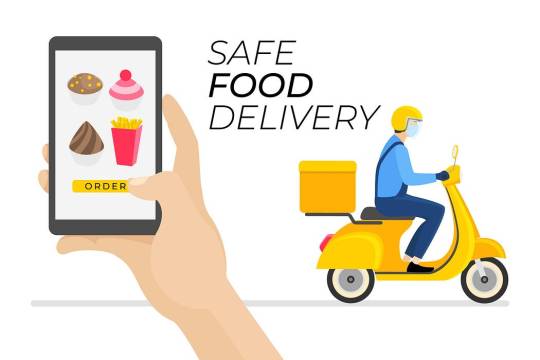
Accepting Orders, Enhancing Experiences:
With Shopurfood’s UberEats clone software, you can elevate your customers’ experience by accepting online food orders seamlessly. This not only streamlines the ordering process but also opens the door to a wider customer base, hungry for the delights your restaurant has to offer.
Tracking Deliveries for Transparency:
One key to customer satisfaction is transparency. Shopurfood’s UberEats clone software allows your customers to easily track their orders, keeping them informed and satisfied. This feature not only enhances their experience but also builds trust in your delivery process.
Insights for Operational Excellence:
Keeping a pulse on your restaurant’s operations is made easy with powerful data insight features. Shopurfood’s UberEats clone software provides detailed delivery records, allowing you to make informed decisions and maintain control over your restaurant’s performance.
Bringing Business Ideas to Life:
By combining the power of a website and a mobile food ordering application, powered by Shopurfood’s technology, you can drive more sales to your restaurant business. The branded UberEats clone app ensures your hungry customers can conveniently order food from your establishment, making it a win-win for both sides.
White Label Food Delivery Clone:
Choosing the right UberEats clone is crucial for growth. Shopurfood’s comprehensive food delivery system’s admin panel gives you access to manage menus, restaurants, orders, commission tracking, payments, and reports. The white-label food delivery clone script comes with built-in features tailored to understand your restaurant business completely.
Feature-Rich UberEats Clone:
Save time and stay productive with Shopurfood’s UberEats clone’s innovative features. Accepting online payments and tracking fast-selling food items streamline the online food delivery process, ensuring your restaurant stays ahead of the competition.
Unlimited Orders: Add as many restaurants and locations as you want, with no extra cost.
Scheduled Orders: Allow customers to order in advance through the website and mobile app.
Coupon Codes: Delight customers with seasonal offers and personalized promo codes.
Wallet System: Securely add money and pay instantly for food orders.
Integration: SMS, email, and payment gateway integrations for a seamless ordering experience.
Reward Points: Retain customers by rewarding them for each order they place.
Order Alerts: Receive instant notifications with detailed information on every customer order.
Detailed Reports: Analyze restaurant reports for revenue opportunities and optimization.
Manage Inventory: Intuitive tools for managing inventory, available items, and stock information in one window.
In Conclusion,
Shopurfood’s UberEats Clone Software is not just a food delivery solution — it’s a strategic tool for restaurants looking to thrive in the competitive world of online ordering. Whether you’re a small eatery or a large establishment, embracing the features of this software can significantly impact your business’s efficiency and profitability. Get ahead, stay ahead, and elevate your restaurant’s online presence with Shopurfood’s customized UberEats Clone Software today.
#food ordering software#food panda clone#food delivery services#food delivery#food#restaurant business software#restaurant management software#restaurant business#restaurants#ubereats clone app#ubereats clone#ubereats clone software#ubereats clone script#ubereats clone solution#shopurfood
1 note
·
View note
Text
How to Scrap Food Data with Python & Google Collab?

In today's digital age, data is king. Companies and businesses rely on data to make informed decisions and stay ahead of the competition. But where does this data come from? One source is web scraping, the process of extracting data from websites. In this article, we will explore how to scrap food data with Python and Google Collab, a free online platform for coding and data analysis.
What is Web Scraping?
Web scraping is the process of extracting data from websites using automated tools or scripts. It allows you to gather large amounts of data quickly and efficiently, without having to manually copy and paste information from websites. This data can then be used for various purposes, such as market research, data analysis, and more.
Why Scrape Food Data?
Food data is a valuable source of information for businesses in the food industry. It can provide insights into consumer preferences, trends, and market demand. By scraping food data, businesses can stay informed about their competitors, track prices, and make data-driven decisions.
Setting Up Google Collab
Before we can start scraping, we need to set up our environment. Google Collab is a great option for this as it provides a free online platform for coding and data analysis. To get started, go to https://colab.research.google.com/ and sign in with your Google account. Once you're in, create a new notebook by clicking on "File" and then "New Notebook."
Installing Necessary Libraries
To scrape data with Python, we will need to install a few libraries. In your Google Collab notebook, run the following code in a code cell:
!pip install requests !pip install beautifulsoup4
This will install the necessary libraries for web scraping.
Scraping Food Data
Now that we have our environment set up, we can start scraping food data. For this example, we will scrape data from a popular food delivery website, Grubhub. We will extract the name, price, and description of the top 10 items from a specific restaurant.
First, we need to import the necessary libraries and define the URL we want to scrape:
import requests from bs4 import BeautifulSoup
url = "https://www.grubhub.com/restaurant/restaurant-name/menu"
Next, we will use the requests library to get the HTML content of the webpage and then use BeautifulSoup to parse the HTML:
page = requests.get(url) soup = BeautifulSoup(page.content, 'html.parser')
Now, we can use find_all to find all the items on the menu and loop through them to extract the desired information:
items = soup.find_all(class_="menuItem") for item in items[:10]: name = item.find(class_="menuItem-name").get_text() price = item.find(class_="menuItem-price").get_text() description = item.find(class_="menuItem-description").get_text() print(name, price, description)
This will print out the name, price, and description of the top 10 items from the restaurant's menu.
Conclusion
Web scraping is a powerful tool for extracting data from websites. In this article, we explored how to scrape food data with Python and Google Collab. By following these steps, you can gather valuable information for your business and stay ahead of the competition. Happy scraping!
#restaurant data scraping#food data scraping#grocerydatascraping#web scraping services#zomato api#restaurantdataextraction#food data scraping services#fooddatascrapingservices#grocerydatascrapingapi#usa#Google Maps Data Scraping#Python & Google Colab#Python programming
0 notes
Text
How to Enhance Your Food Delivery Business with Data Scraping from Mobile Apps?
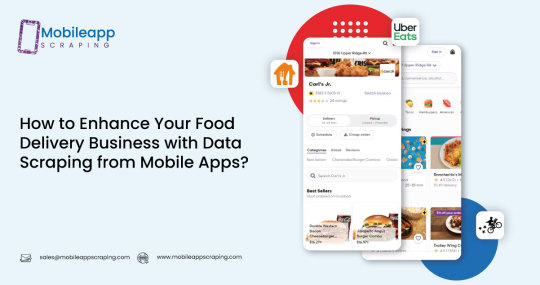
How to Enhance Your Food Delivery Business with Data Scraping from Mobile Apps?
July 29, 2023
Food Delivery Mobile App Data Scraping
Welcome to Mobile App Scraping's Food Delivery Apps Data Scraping service, designed to help businesses in the food industry unlock the potential of data. In the fast-paced world of food delivery, staying ahead of the competition requires access to real-time and comprehensive information from popular food delivery apps. Our specialized scraping service allows businesses to extract valuable data from these apps, including restaurant details, menu items, prices, customer reviews, delivery times, etc. With this valuable data, businesses can make data-driven decisions, optimize operations, enhance customer satisfaction, and gain a competitive advantage. Experience the power of data with Mobile App Scraping's Food Delivery Apps Data Scraping service and take your food business to new heights!
What Is Food Delivery Mobile App Data Scraping Service And How Does It Work?
Food delivery mobile app data scraping service refers to extracting relevant information and data from food delivery applications. It uses specialized tools and techniques to gather data such as restaurant details, menus, prices, customer reviews, ratings, and delivery information from popular food delivery apps.
Data Identification: The specific data points to be scraped from the food delivery app are identified based on the business requirements. This could include restaurant names, menus, pricing details, customer ratings, and reviews.
Scraping Methodology: A scraping methodology is developed based on the structure and layout of the food delivery app. This involves understanding the app's HTML structure, API calls, or other mechanisms to access and retrieve the desired data.
Scraping Execution: The scraping tool or script is executed to visit the food delivery app and extract the identified data points. The scraping tool simulates user interactions and navigates through the app's pages to collect the desired information.
Data Extraction and Transformation: The scraped data is extracted and transformed into a structured format that businesses can quickly analyze and utilize. This may involve cleaning the data, removing duplicates, and organizing it into a consistent format.
Data Delivery: The extracted data is delivered to businesses in the desired format, CSV, JSON, or database format. The data can be directly accessed or integrated into the business's existing systems or applications for further analysis and decision-making.
It's important to note that food delivery mobile app data scraping should be done in compliance with legal and ethical guidelines, respecting the terms of service of the app being scraped. Additionally, businesses should ensure they have the necessary permissions and rights to use the scraped data for their intended purposes.
Which Food Delivery Apps Can Be Targeted For Data Scraping?
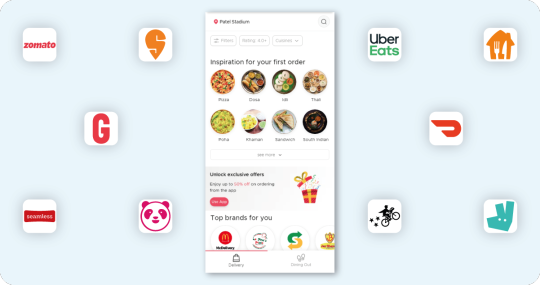
The food delivery apps that can be targeted for data scraping may vary depending on their accessibility and specific scraping capabilities. However, some popular food delivery apps that are commonly targeted for data scraping include:
Uber Eats
DoorDash
Grubhub
Postmatesa
Deliveroo
Zomato
Swiggy
Just Eat
Foodpanda
Seamless
These apps provide a wealth of data related to restaurants, menus, prices, customer reviews, ratings, and delivery information. However, it's important to note that scraping these apps should be done in compliance with legal and ethical guidelines, respecting the terms of service of each app. Additionally, the availability and accessibility of data for scraping may be subject to changes or restrictions imposed by the app providers.
What Types Of Data Can Be Extracted From Food Delivery Mobile Apps?
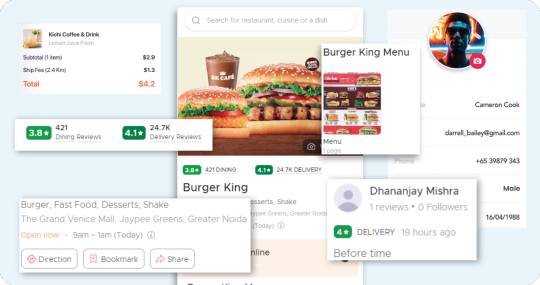
Food delivery mobile apps provide a wide range of data that can be extracted through scraping. Here are some common types of data that can be extracted from food delivery mobile apps:
Restaurant Details: Information about restaurants such as name, location, contact details, operating hours, and delivery areas.
Menus: The complete menu listings of restaurants, including item names, descriptions, prices, and available customization options.
Pricing Information: Details about the prices of individual menu items, combo meals, discounts, and delivery fees.
Customer Reviews and Ratings: Feedback and ratings provided by customers regarding their experiences with specific restaurants and dishes.
Delivery Information: Data related to delivery options, estimated delivery times, delivery partners, and tracking information.
Restaurant Images: Images and visual content associated with restaurants, menu items, and promotional offers
Cuisine and Dietary Information: Classification of restaurants and menu items based on cuisine types, dietary preferences (e.g., vegetarian, gluten-free), and allergen information.
Order History: Historical data related to customer orders, including order IDs, timestamps, order contents, and transaction details.
Promotions and Discounts: Information about ongoing promotions, discounts, special offers, and loyalty programs.
Restaurant Ratings and Popularity: Data indicating the popularity and ratings of restaurants based on customer feedback and order volumes.
Geolocation Data: Geographical coordinates or addresses associated with restaurants, enabling analysis of regional preferences and market trends
User Profiles: Basic user information, including names, addresses, contact details, and order history.
The availability and specific data types may vary across food delivery apps and their respective APIs or app interfaces. It's essential to adhere to legal and ethical guidelines and the terms of service of the app being scraped when extracting data from food delivery mobile apps.
How Frequently Is The Scraped Data Updated And How Is It Delivered To Businesses?
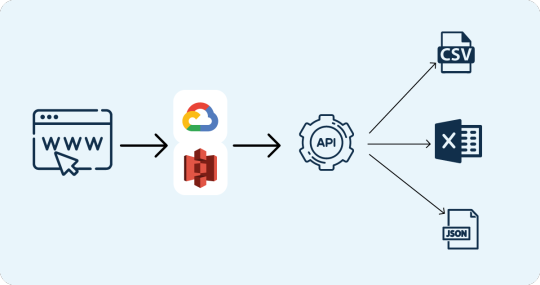
The frequency of data updates and the delivery method can vary depending on the specific requirements of the business and the scraping setup. Here are a few factors to consider:
Data Update Frequency: The scraped data can be updated based on the desired frequency, ranging from real-time to periodic updates. Real-time updates require continuous scraping to capture the latest data as it becomes available on the food delivery app. Periodic updates can be scheduled at specific intervals, such as daily, weekly, or monthly, to capture changes over time.
Delivery Method: The scraped data can be delivered to businesses in different formats depending on their preferences and needs. Standard delivery methods include:
a. File Downloads: The scraped data can be provided as downloadable files in CSV, JSON, or Excel. These files can be easily accessed and imported into the business's data analysis tools or systems.
b. API Integration: The scraped data can be delivered through an API (Application Programming Interface) that businesses can integrate directly into their systems. This allows for seamless and automated data transfer, enabling real-time updates and direct integration into existing applications or databases.
c. Cloud Storage or FTP: The scraped data can be stored in platforms like Amazon S3, Google Cloud Storage, or Microsoft Azure Blob Storage. Alternatively, businesses can deliver data through FTP (File Transfer Protocol) servers, where the scraped data is available for secure download.
Customization and Scheduling: The delivery of scraped data can be customized to align with the specific requirements of businesses. This may include filtering specific data points, generating reports, or customizing the data structure to meet the business's analysis or integration needs. Additionally, data delivery can be scheduled to occur at specific times or intervals to ensure timely updates.
Can The Scraping Service Extract Data Specific To Certain Locations Or Cuisines?
The scraping service can be customized to extract data specific to certain locations or cuisines from food delivery mobile apps. This customization allows businesses to focus on their target markets or culinary preferences. Here's how the scraping service can achieve this:
Location-Based Data Extraction: The scraping service can be configured to target food delivery apps for specific geographic locations. By specifying the desired cities, regions, or countries, the scraping service can extract data related to restaurants, menus, prices, and delivery options available in those particular areas. This enables businesses to gather localized data and gain insights into regional market trends and consumer preferences.
Cuisine-Based Data Extraction: The scraping service can be tailored to extract data based on specific cuisines. By specifying the desired cuisine types, such as Italian, Chinese, Mexican, or vegetarian/vegan options, the scraping service can retrieve information about restaurants offering those cuisines, their menus, pricing, and customer reviews. This allows businesses to focus on analyzing data specific to their chosen culinary domain and make informed decisions based on those insights.
Combined Location and Cuisine Filtering: The scraping service can also provide the capability to combine location and cuisine filtering. This means businesses can extract data for specific cuisines in particular locations, refining the scraped data to match their target market or customer preferences more accurately.
Businesses can obtain highly relevant and targeted information by customizing the scraping service to extract data specific to certain locations or cuisines. This enables them to better understand local market dynamics, tailor their offerings, and make strategic decisions that align with their target audience or culinary specialization.
How Can Businesses Benefit From Scraped Data From Food Delivery Apps From Mobile App Scraping?
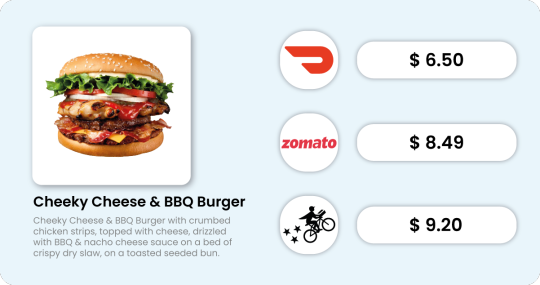
Businesses can benefit in several ways from the scraped data obtained from food delivery apps through Mobile App Scraping:
Market Analysis: The scraped data provides businesses valuable insights into the food delivery market, including popular restaurants, trending cuisines, customer preferences, and pricing trends. This information helps businesses identify market gaps, emerging opportunities, and potential areas for growth.
Competitor Analysis: By analyzing the data from food delivery apps, businesses can gain a competitive edge by understanding their competitors' offerings, pricing strategies, customer reviews, and delivery times. This allows businesses to benchmark their performance, differentiate themselves, and develop strategies to attract and retain customers.
Menu Optimization: The scraped data provides businesses with a comprehensive view of menus offered by various restaurants. This helps businesses optimize their menus by identifying popular dishes, analyzing customer reviews, and incorporating trending or in-demand items. By offering a well-curated and attractive menu, businesses can increase customer satisfaction and order volumes.
Pricing Strategy: The pricing data obtained through scraping allows businesses to analyze the pricing patterns of different restaurants and menu items. By understanding market dynamics and customer behavior, businesses can optimize their pricing strategies to remain competitive while maximizing profitability.
Customer Insights: The scraped data includes valuable customer reviews, ratings, and feedback. By analyzing this information, businesses can gain insights into customer preferences, satisfaction levels, and areas for improvement. This knowledge helps enhance the overall customer experience, address concerns, and foster customer loyalty.
Targeted Marketing: The scraped data enables businesses to target their marketing efforts effectively. By understanding customer preferences, popular cuisines, and ordering patterns, businesses can personalize marketing campaigns, offer relevant promotions, and drive customer engagement and conversion rates.
Operational Efficiency: The scraped data provides information about delivery times, order volumes, and customer feedback. This helps businesses optimize operations by streamlining delivery processes, managing resources efficiently, and improving overall service quality.
Strategic Decision-making: The insights from scraped data empower businesses to make data-driven strategic decisions. Whether expanding into new markets, partnering with specific restaurants, or introducing new menu items, businesses can leverage the scraped data to identify growth opportunities and mitigate risks.
Mobile App Scraping' scraped data from food delivery apps provide businesses with accurate and up-to-date information, allowing them to make informed decisions, improve operational efficiency, enhance customer satisfaction, and drive growth in the competitive food delivery industry.
What Level Of Customization Or Filtering Options Are Available For The Scraped Data?
Mobile App Scraping offers a high level of customization and filtering options for scraped data to meet the specific needs of businesses. Here are some of the customization and filtering options available:
Location-Based Filtering: The scraped data can be filtered based on specific geographic locations. Businesses can specify the desired cities, regions, or countries to focus on, ensuring that the extracted data aligns with their target markets or areas of interest.
Cuisine-Based Filtering: The scraped data can be filtered based on specific cuisines. Businesses can choose to extract data related to particular cuisine types such as Italian, Chinese, Mexican, vegetarian, or any other specific culinary preferences. This allows businesses to obtain data relevant to their chosen food categories and better understand customer preferences in those culinary domains.
Data Fields Selection: Mobile App Scraping allows businesses to customize the data fields they want to extract from food delivery apps. Businesses can select specific data points such as restaurant names, menus, prices, customer ratings, delivery times, and other relevant information. This level of customization ensures that businesses only receive the required data, making it more manageable and tailored to their specific needs.
Frequency of Data Updates: Data updates can be customized based on business requirements. Mobile App Scraping can provide real-time updates or schedule periodic updates at specific intervals, such as daily, weekly, or monthly. This ensures businesses receive the most current and relevant data to support their decision-making processes.
Data Format and Delivery: Mobile App Scraping offers flexibility in delivering the scraped data in various formats such as CSV, JSON, Excel, or through API integration. This allows businesses to receive the data in a format compatible with their existing systems and analytical tools, facilitating seamless integration and analysis.
Advanced Filtering and Sorting: Mobile App Scraping can implement advanced filtering and sorting mechanisms based on specific criteria, such as ratings, popularity, price range, or delivery time. This enables businesses to focus on specific subsets of data most relevant to their analysis and decision-making processes.
By providing a wide range of customization and filtering options, Mobile App Scraping ensures that businesses receive the scraped data tailored to their unique requirements. This empowers businesses to extract meaningful insights, make informed decisions, and drive their growth strategies more effectively.
Unlock the power of data for your food delivery business with Mobile App Scraping' Food Delivery Mobile App Data Scraping service. Gain a competitive edge by leveraging valuable insights from popular food delivery apps. Customize and filter the data based on locations, cuisines, and specific data fields to align with your business objectives. With real-time or periodic updates and flexible data delivery options, we provide you with the latest and most relevant information. Make informed decisions, optimize menus, refine pricing strategies, and enhance customer satisfaction. Take your food delivery business to new heights with Mobile App Scraping' Food Delivery Mobile App Data Scraping service. Contact us today to unlock the potential of your data-driven success.
know more: https://www.mobileappscraping.com/enhance-food-delivery-business-with-apps-scraping.php
0 notes
Text
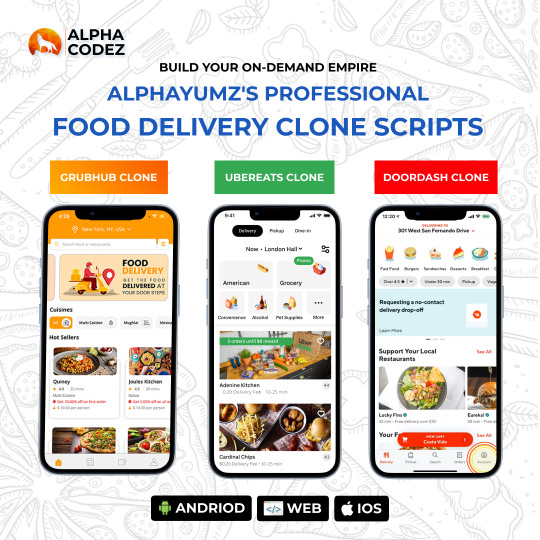
Enter the booming food delivery market with Alphayumz's premier clone scripts. Emulate industry giants like Doordash, UberEats, and Grubhub effortlessly.
Alphacodez advanced solutions offer real-time tracking, restaurant variety, easy payment, and seamless user experiences. Customize, deploy rapidly, and tap into the immense potential of on-demand food delivery.
Your path to success starts here
Website : https://www.alphacodez.com/ Mail : [email protected]
0 notes
Link
Get local food delivery apps like Grubhub and let your customers enjoy the delicacies that you want. GrubHub App clone script is available on Android and iOS
1 note
·
View note
Link
The entry of on-demand services has revolutionized the food industry. The food delivery services are now reaching out to customers who are willing to order through apps. It has become essential to own a food delivery app to handle a bundle of tasks from ordering food to dispatch. With our team of seasoned developers, you can develop your GrubHub clone app with insightful features and extensive customization. Set up your venture with an invaluable food ordering script in no-time and at a fraction of the cost. Let’s begin!
1 note
·
View note
Link

#doordash clone#doordash clone script#food delivery script#food ordering script#food ordering software#food delivery app clon#online food ordering system php#ubereats clone#foodpanda clone#swiggy clone#grubhub clone#justeat clone
1 note
·
View note
Text
How Grubhub Clone Can Increase Your Profit!
If you want to make people's life easier? then start a food delivery business. One fine example is Grubhub - a popular food ordering and delivery service that serves around 33.8 million active customers.
What is GrubHub Clone?
GrubHub clone is a readymade software that helps business owners to start their food delivery business in no time. It allows your customers to order their favorite food online and deliver it to customers doorstep.
The readymade software must have minimalistic features and be built with advanced technologies for better performance and scalability in the future.
How can it increase your profit?
Due to its sustainable business model, Grubhub is very successful in the US market for the past 16 years. It generated $2.1 billion in revenue in 2021, Which is a 16% increase year-on-year.
As you are planning to run a food delivery business online, it is mandatory to provide a faster and better service. The reason is nowadays more businesses are adding value to their customers by digitizing their products/services. As a result, it automatically increases the revenue of your company and on the other hand, it stabilizes your customer base.
Therefore, the Grubhub clone helps you to digitize your business in the food delivery market. The right technology and convenient features attract new customers in many ways.
Must-have features in the Grubhub clone
Four panels are available on the Grubhub clone - user application, driver application, Restaurant panel, and admin panel. Let’s briefly have a look,
User app
Search nearby Restaurants - This allows customers to search their favorite restaurants.
Real-time order tracking - Users can track their orders with the driver’s live location and delivery time.
Payment options - This allows the user to pay with multiple payment options like Cash, card, or wallet.
Driver App
Navigation - One of the must-have features in the driver app. This allows drivers in showing the direction to the exact location of the restaurant and the eater.
Ratings - This feature allows drivers to rate the delivery experience in real time.
Earnings - This help drivers view their earnings based on weekly and monthly.
Restaurant panel
Order Management - A mandatory feature for every restaurant. It allows them to manage all the upcoming and past orders from the restaurant panel.
Operating hours - It allows restaurant owners to set operating hours for their business.
Transaction Management - This helps restaurant owners to manage and view past and future transactions.
Admin panel
Service fee management - Allows admin to manage and set the service fee for the user, driver, and restaurant from the admin panel.
Auto payout - It’s a mandatory feature since it prevents the admin from processing the payout manually. With the help of auto payout, the platform can automatically transfer the payout to drivers and restaurants easily.
Dashboard - The dashboard can help the admin view all the details about the total number of users, drivers, restaurants, bookings and earning reports, etc,
Conclusion
With the help of futuristic technology and advanced features, you can easily launch a food delivery business into your market.
All you need to do is to choose a wise Grubhub clone by undergoing deep research. In order to build an app like Grubhub, you can check WooberlyEats.
Reach out to Whatsapp to know more about WooberlyEats.
0 notes
Text
Just eat clone
Just eat clone developed by www.foodorderingscript.com Customer app, Restaurant App, Driver app Start your own Food Ordering Business with the Best Just Eat Clone in the industry.
1 note
·
View note
Link
Get our best Grubhub clone app that facilitates complete online food delivery solutions. AIS Technolabs provides Grubhub clone script that can easily be customized, added with 3rd party libraries.
0 notes
Link
Planning to invest in the best supermarket software for your business? If yes, you must have heard about Groceryncart, a white labeled food delivery app for all your restaurant business.
0 notes
Link
#Grocery delivery apps development#Grofers Clone#GrubHub clone#Grocery Delivery Script#grocery ordering system#Online grocery store software#online ordering system#instacart clone#bigbasket clone#Postmates clone#Amazonfresh clone
1 note
·
View note
Link
Are You Looking for the Best Grubhub Clone Script. Launch your own Online food delivery Apps Like Grubhub. Grubhub clone app is the easiest and safest way to attract users.
0 notes